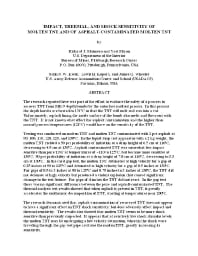Mining Publication: Impact, Thermal, and Shock Sensitivity of Molten TNT and of Asphalt-Contaminated Molten TNT
Original creation date: July 1996
Authors: RJ Mainiero, Y Miron, SS Kwak, LH Kopera, JQ Wheeler
NIOSHTIC2 Number: 20023924
Proceedings of the 22nd Annual Conference on Explosives and Blasting Technique, Orlando, FL, Intl Society of Explosives Engineers, 1996; Jul :179-197
The research reported here was part of the effort to evaluate the safety of a process to recover TNT from MK-9 depth bombs by the autoclave meltout process. In this process the depth bombs are heated to 121 deg C so that the TNT will melt and run into a vat. Unfortunately, asphalt lining the inside surface of the bomb also melts and flows out with the TNT. It is not known what effect the asphalt contamination and the higher than normal process temperatures (121 deg C) would have on the sensitivity of the TNT. Testing was conducted on molten TNT and molten TNT contaminated with 2 pct asphalt at 90, 100, 110, 120, 125, and 130 deg C. In the liquid drop test apparatus with a 2 kg weight, the molten TNT yielded a 50 pct probability of initiation at a drop height of 6.5 cm at 110 deg C, decreasing to 4.5 cm at 130 deg C. Asphalt-contaminated TNT was somewhat less impact sensitive than pure TNT at temperatures of -110 to 125 deg C, but became more sensitive at 130 deg C; 50 pct probability of initiation at a drop height of 7.8 cm at 110 deg C, decreasing to 3.3 cm at 130 deg C. In the card gap test, the molten TNT detonated at high velocity for a gap of 0.25 inches at 90 to 125 deg C and detonated at high velocity for a gap of 0.5 inches at 130 deg C. For gaps of 0.5 to 3 inches at 90 to 125 deg C and 0.75 inches to 3 inches at 130 deg C, the TNT did not detonate at high velocity but produced a violent explosion that caused significant damage to the test fixture. For gaps of 4 inches the TNT did not react. In the gap test there was no significant difference between the pure and asphalt-contaminated TNT. The thermal analysis test results showed that when asphalt is present in TNT, it greatly accelerates the exothermic decomposition of TNT, starting at temperatures near 200 deg C. The research demonstrated that asphalt-contamination of recovered TNT does not appear to have a significant effect on TNT shock sensitivity, but does adversely affect impact and thermal sensitivity. The results also showed that molten TNT seems to be more shock sensitive than previously suspected. It appears that at relatively low shock stimulus levels, the molten TNT may be undergoing a low velocity detonation, wherein the shock wave traveling through the gap test pipe cavitates the molten TNT, greatly increasing its sensitivity.

NIOSHTIC2 Number: 20023924
Proceedings of the 22nd Annual Conference on Explosives and Blasting Technique, Orlando, FL, Intl Society of Explosives Engineers, 1996; Jul :179-197
- Coal-Dust Explosion Tests in the Experimental Mine 1919 to 1924, Inclusive
- Evaluation of the Bagged Stone Dust Barrier Effectiveness in a Bord and Pillar Mine
- Explosion Pressure Design Criteria for New Seals in U.S. Coal Mines
- Progress Toward Improved Engineering of Seals and Sealed Areas of Coal Mines
- Rock Dusting Considerations in Underground Coal Mines
- Technology News 489 - Reducing the Danger of Explosions in Sealed Areas (Gobs) in Mines
- Technology News 515 - Float Coal Dust Explosion Hazards
- Technology News 535 - NIOSH Releases New Educational Video: Escape from Farmington No. 9: An Oral History
- Thermal Stability of ANFO Made with Recycled Oil
- Use of Ground Penetrating Radar and Schmidt Hammer Tests to Determine the Structural Integrity of a Mine Seal